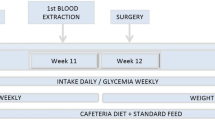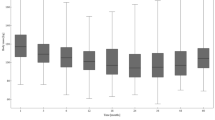Abstract
Background
A new bariatric surgical experimental model in rats for aspects of investigation was created.
Methods
In 121 male Wistar rats with body mass 250–270 g, the original gastric banding (GB) operation was performed. Sixty days after the surgical procedure, we measured body mass and upper part of the alimentary tract patency (radiography with contrast medium).
Results
One hundred twenty one rats were operated on. In the study group, the mortality was 0%. A complication (incisional hernia) was found in only three cases. The average weight of the rat in the GB group on the 60th day after the surgery was 355.0 ± 4.12 g, and that in the sham-operation group was 394.0 ± 4.80 g (t test, t = 6,073, p < 0.001). The daily weight gain in sham-operated rats was 2.23 ± 0.07 g, whereas in the GB group, it was 1.60 ± 0.07 g (p < 0.02). Complete inhibition of weight gain was not observed.
Conclusion
The rat model of GB surgery that we created is easy to perform, repeatable, long-lasting, relatively cheap, and can be used in various experimental trials of diverse aspects of surgery in the field of obesity.





Similar content being viewed by others
References
Flegal KM, Caroll MD, Odgen CT, Johnson CL. Prevalence and trends in obesity among US adults, 1999–2000. JAMA. 2002;288:1723–27.
Greenway S, Klein S. Effects of obesity surgery on non-insulin-dependent diabetes mellitus. Arch Surg. 2002;137:1109–17.
Coelho JC, Solhaug JH, Moody FG, Li YF. Experimental evaluation of gastric banding for treatment of morbid obesity in pigs. Am J Surg. 1985;149:228–31.
Badura R, Buczek A, Bieniek J, Kaszubkiewicz C, Oleszkiewicz L, Wiercinski W. The effect of gastric banding on body weight in experimental animals. Pol Arch Weter. 1987;27:5–14.
Skarstein A, Lekven J. Influence of gastric banding on stomach blood supply with or without concurrent splenectomy. Am J Surg. 1985;149:351–6.
Geliebter A, Westreich S, Gage D, Hashim SA. Intragastric balloon reduces food intake and body weight in rats. Am J Physiol. 1986;25:794–7.
Monteiro MP, Monteiro JD, Aguas AP, Cardoso MH. Rats submitted to gastric banding are leaner and show distinctive feeding patterns. Obes Surg. 2006;16:597–602.
Monteiro MP, Monteiro JD, Aguas AP, Cardoso MH. A rat model of restrictive bariatric surgery with gastric banding. Obes Surg. 2006;16:48–51.
Endo Y, Ohta M, Kai S, Kitano S. An obese rat model of bariatric surgery with gastric banding. Obes Surg. 2007;17:815–9.
de Bona Castelan J, Bettiol J, d’Acampora AJ, Castelan JV, de Souza JC, Bressiani V, et al. Sleeve gastrectomy model in Wistar rats. Obes Surg. 2007;17:957–61.
Author information
Authors and Affiliations
Corresponding author
Rights and permissions
About this article
Cite this article
Rokicki, W., Rokicki, M. & Rokicki, W. The Original Experimental Model in Rats to Study Gastric Banding Surgery. OBES SURG 18, 686–689 (2008). https://doi.org/10.1007/s11695-007-9387-5
Received:
Accepted:
Published:
Issue Date:
DOI: https://doi.org/10.1007/s11695-007-9387-5




